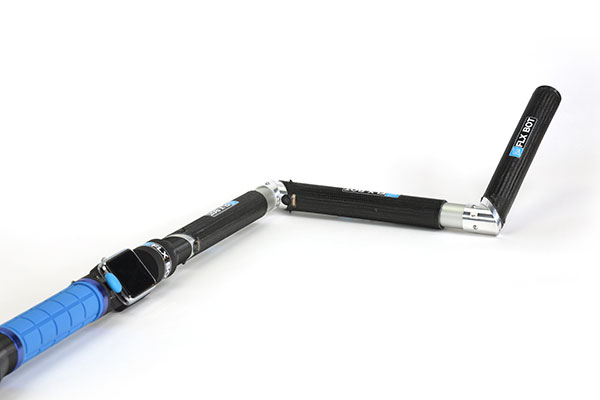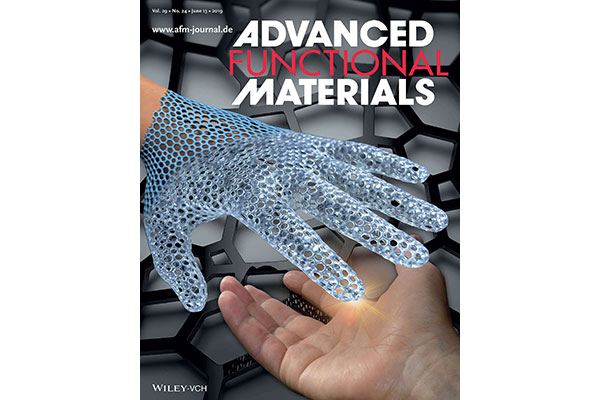Logged On, Plugged in, 3D Printed
In the world of robotics, 3D printing’s ability to print lightweight, complex shapes make it a natural fit for high-value, low-volume robot parts.

FLX Solutions regularly deploys 3D printing to output prototypes and small-scale runs of its FLX Bot snake-like robot for operations and maintenance. Image courtesy of FLX Solutions.
Additive Manufacturing News
Additive Manufacturing Resources


Boston Micro Fabrication

Latest News
March 10, 2023
When you’re an entrepreneur trying to staff a startup and commercialize a product born from a Ph.D. dissertation, you have an appetite for any tool that can help reduce development costs and push product to market faster.
For Matt Bilsky, CEO of FLX Solutions, that solution was 3D printing technologies, via an $800 Prusa 3D printer used for early concepting to a trial run of a Boston Micro Fabrication high-precision printer that output a gearbox for a prototype of the FLX Bot, a snake-like robot for maintenance and repair operations.
As the FLX Bot inches closer to full-scale production, the FLX Solutions team is expanding use of 3D printing, using next-generation materials such as composites along with metal fusion technologies contracted through external service provider engagements. Fellow startups and companies alike can appreciate FLX Solutions’ goal: to pump out highly functional prototypes and end-use parts without the time and expense associated with custom machining and tooling, Bilsky says.
“It’s not possible to run a hardware startup today without 3D printing,” Bilsky says. “What you would go and do at a machine shop 10 years ago, you can now just 3D print. What used to take months in a machine shop and cost tens of thousands of dollars to make out of metal, you can now print out of plastic on a low-cost printer and get the answer you need.”
Where 3D Printing Can Help
Like FLX Solutions, a growing number of startups, established players and university research centers that innovate in the robotics field are stepping up their 3D printing use throughout various stages of the development and production lifecycle. Additive manufacturing (AM) has become a more attractive alternative for robotics systems makers as the technology matures, adding advanced materials options and gaining in performance and sophistication. It’s also become far easier for innovators to plan 3D print builds, ensure high-strength, quality part output and more easily facilitate any necessary post-processing work—advancements that have fueled adoption of AM across industries.

Purdue University team developed a new design method to 3D print soft bots that mimic human motion. Image courtesy of Purdue University.
AM’s core strengths: The ability to optimize via lattice structures and lightweight complex designs that couldn’t be output with traditional manufacturing methods—also play to the natural synergies between robotics use cases and 3D printing. Consider an industrial robot arm loaded up with sensors to drive automation—all of those onboard electronics capabilities increase the robot arm’s payload, which in turn, can significantly degrade operations. Lightweighting component designs, one of 3D printing’s strong suits, can be a game changer in how the robot performs its duties.
“Being able to optimize specifically for things like weight reduction can have a significant impact on a robot’s overall performance,” says Patrick Dunne, vice president of advanced applications for 3D Systems. “An industrial robot component that’s lightweighted can move faster because there’s less inertia so it can accelerate and decelerate with some degree of precision.”
Also, according to Dunne, the heavier a component is, the more wear and tear it experiences. With that context, Dunne says a heavyweight industrial robot has a shorter mean time between failure windows, which increases the likelihood of maintenance procedures that take the robot offline and expose the factory to unwanted downtime.
AM’s ability to turn out parts with lattice structures and hollowed-out shapes lends itself to the production of end effectors, or the vast portfolio of accessories and add-ons that turn a generic industrial robot into something customized for a specific use case. While the range is wide and varied, an end effector is typically mechanical or electromechanical and could incorporate some soft material capabilities. Among the more prevalent end effector examples are grippers, sensors and process tools.
“We’re tasking robotics systems with interesting use cases, from pick and place robots in factories to drones designed to complete a certain job,” says Tripp Burd, director of new platform for Markforged, a provider of industrial-grade 3D printers. “Because of that, we need the ability to adapt and focus the payload package to conformally grip things, work in a narrow operating environment or do a specific job. 3D printing delivers the ability to make complex attachments to solve targeted jobs with a fast turnaround time.”
Economic concerns govern every manufacturing decision, and here as well, 3D printing offers some key advantages. Many typical robotics system use cases check the box of low-volume production of highly valuable parts—a critical metric often used to justify AM’s higher per-part cost compared to traditional injection molding or machining production methods.
“Traditional manufacturing methods are great when you tool up and make things of a repeatable nature,” Burd says. “But the nature of the robotics industry is higher value, lower production volume applications so additive manufacturing is a perfect solution. There is no hard tooling, no large upfront investment and you can prototype and iterate quickly to move into production with the same platform you developed on.”
3D Printing At Work
AM was the driving force behind Haddington Dynamics’ decision to leverage Markforged 3D printers to expedite the launch of its open-source Dexter 3D printed robot arm. The initial Dexter robot was made from laminated wood, paper and a laser cutter with a polylactic acid (PLA) 3D printer eventually introduced to create parts at a more cost-effective price point. The PLA material didn’t hold up so the team redesigned the robot with carbon fiber layup using Markforged desktop 3D printers to consolidate high-precision parts—eventually shrinking the 3D printed robot arm kit down from 800 parts to 70. The Markforged 3D printers also made it easier to create custom end effectors like fingers that could pick up customer items and streamlined operations.
Dexter’s current iteration is made almost entirely of Markforged printed parts and given the tolerance accuracy of the printer, Haddington can 3D print a Dexter robot arm and ship it straight off the print bed to a customer.
“Given the performance, accuracy and cost-per-component, Haddington can move straight into production and stand up microfactories positioned near the point of use,” Burd says.
FarmDroid, a field robot used in agriculture to automate sowing and weed removal, is also leveraging a fleet of Markforged 3D printers to scale from prototyping to a limited number of units, a scenario it dubs 0 series production. Before investing in injection molding, which is costly, has long lead times, and offers limited flexibility for design changes, FarmDroid is testing designs with 3D prints in Markforged Onyx composite materials that come close to the ones used in latter-stage production.
“3D-printed parts can be used for prototyping, testing tools and also for production parts,” says René Jannick Jørgensen, FarmDroid’s CEO. “We have come a long way compared to just using traditional manufacturing technologies.”
Coming Down the Pike
In addition to the growing number of startup and enterprise use cases, there is ample activity in research labs and universities to make greater use of 3D printing for robotics applications. Soft robotics is one notable area of focus. This new class of machines, constructed from soft materials engineered to mirror the properties of soft biological tissue, are being explored for healthcare and human assistance applications. New materials such as specialized polymers and gels are being cast in 3D printed molds or directly 3D printed to create improved traditional objects such as grippers that robots use to pick up objects and perform care-related tasks.
Purdue University researchers are on the case to explore how 3D printing can fabricate soft robots for caregiving applications. The hard structure of current caregiving robots limits their usability from a safety standpoint when actually interacting with humans.
The Purdue University team developed a new design method to 3D print these soft bots, starting with a 3D CAD file that depicts the robot’s shape, which is then painted to show the direction of the robot’s joint movement. An algorithm then converts the CAD model into a 3D architected soft machine (ASM) that can be printed using any conventional 3D printer, the Purdue researchers said. The ASM moves like a human, relying not on muscles, but on miniaturized motors that pull from nylon lines tied to the end of their limbs, according to a writeup on the Purdue University site.
The Massachusetts Institute of Technology is also experimenting with 3D printing shape-shifting structures that could empower soft bots. One research team has developed a method for 3D printing materials with adjustable mechanical properties, which means they sense how the materials move and interact with the environment. The method opens up opportunities for embedding sensors within architected materials, which are programmed with specific mechanical properties for stiffness or toughness.
The technique could create flexible soft robots with embedded sensors that can understand its posture and movements or to create wearable devices that deliver feedback on how a person is moving or interacting with the environment, according to Lillian Chin, a graduate student involved in the project at the MIT Computer Science and Artificial Intelligence Laboratory (CSAIL).
Another MIT research team is 3D printing structures that can change shape and move using magnetism—which is a potential opening for future biomedical robotics applications, according to Xuanhe Zhao, a professor in MIT’s department of mechanical engineering and department of civil and environmental engineering. By using special magnetically infused ink and an electromagnet fitted on the nozzle of a 3D printer, the researchers can orient particles during the print process to direct movement.
“The actuation speed and power density of our printed soft materials with programmed ferromagnetic domains are orders of magnitude greater than existing 3D printed active materials,” the researchers explain in a published paper. “We demonstrate diverse functions derived from complex shape changes, including reconfigurable soft electronics, a mechanical metamaterial that can jump, and a soft robot that crawls, rolls, catches fast-moving objects and transports a pharmaceutical dose.”
While the MIT and Purdue research projects are still highly experimental, plenty of real-world AM technology is available today that can advance robotics system designs and help shorten time to market.
“Think less, print more—the parts are so inexpensive, you can iterate and show people what the system looks like. 3D printing is the answer for rapid iteration, flexibility and the ability to test ideas,” FLX Solutions’ Bilsky says.
More 3D Systems Coverage
More Boston Micro Fabrication Coverage

More Markforged Coverage
Subscribe to our FREE magazine, FREE email newsletters or both!
Latest News
About the Author
Beth Stackpole is a contributing editor to Digital Engineering. Send e-mail about this article to [email protected].
Follow DE



